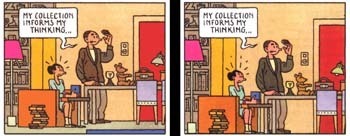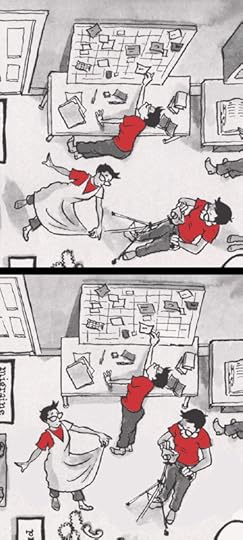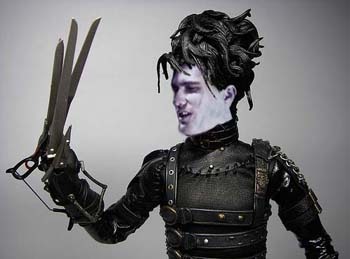David Chelsea's Blog, page 39
July 10, 2012
Frog Chase
Rebecca’s latest summer project Frog Chase, which she animated on the iPAD using cut paper, shed snakeskin net, rippled glass, soil, leaves, and a bear she felted over a wire armature last week, went up on Youtube Sunday, and already has 65 views. You can view it here.
It’s shaping up as a busy summer. Rebecca is already at work on another animation starring Bingo the Cat.
July 7, 2012
EARTH ALERT!
From my pals at INX:
“Please join us on Monday, July 16, for the opening reception of
“EARTH ALERT - INX Artists and the Environment” Curated by Andrea Arroyo.
Meet the Artists reception: Monday, July 16th, 6-8pm . Exhibit on view through August 31, 2012.
The Grady Alexis Gallery, El Taller Latino Americano, 2710 Broadway, 3rd fl., New York, NY 10025.
Gallery Hrs: Mon-Thurs 10am-6pm, Sat 10am-1pm. Free and open to the public.
Contact: Andrea Arroyo, Curator and Gallery Director, The Grady Alexis Gallery, NYC (arroyo212@yahoo.com)
David Chelsea is listening to:
How the Dog Became the Dog: From Wolves to Our Best Friends
by Mark Derr
“Earth Alert - INX Artists and the Environment” features the work of twenty-one artists from INX, an artist-run syndicate for political illustration founded in 1980 by award-winning editorial artists from the U.S. and abroad. The group has produced a weekly package of powerful images in print and online that has been distributed to hundreds of news sources over the past thirty-two years (The Wall Street Journal, The Boston Globe, The Los Angeles Times, The San Francisco Chronicle, The Chicago Tribune, Newsday and The Washington Post among others.)
Participating artists: Michelle Barnes, David Chelsea, Paul Corio, Susann Ferris-Jones, Vivienne Flesher, Felipe Galindo, David Gothard, Ryan Inzana, Randy Jones, Janusz Kapusta, Thomas Kerr, David Klein, Igor Kopelnitsky, Martin Kozlowski, Peter Kuper, Laird Ogden, Sara Schwartz, Jill Karla Schwarz, Rob Shepperson, Brad Teare and Robert Zimmerman.”
I had no advance notice of this show, and don’t know which piece of mine they’ll be showing, but the INX stable are all worthy illustrators, and readers in the New York area should definitely check it out. And definitely check out the recent collection INX Battle Lines: Three Decades of Political Illustration.
June 22, 2012
The Girl With The Keyhole Eyes: See You In September
This just in: the first chapter of my three part comics story The Girl With The Keyhole Eyes has been scheduled for an upcoming issue of the anthology Dark Horse Presents. Here’s a profile of that issue, though it doesn’t go into any detail beyond listing my name with the other contributors (John Layman, Carla Speed McNeil, Tony Puryear, Bo Hampton, Phil Stanford, Nate Cosby, Jimmy Palmiotti, Justin Gray, Richard Corben, Robert Tinnell, Sam Kieth, Patric Reynolds, Evan Shaner and Tony Akins). No matter, I previewed that story on my blog plenty last year when I was working on it.
David Chelsea is listening to:
Rin Tin Tin: The Life and the Legend
by Susan Orlean
The Girl With The Keyhole Eyes preview from last year
Dark Horse Presents #16 goes on sale at a comics shop near you on September 19, 2012.
Format: Full Color, 80 Pages
Price:$7.99
June 21, 2012
RIP, LeRoy Neiman
June 8, 2012
Back To The Return To The Chronic Rift
The old interviews are the best. Here’s one recorded in 1992, from the public access cable program The Chronic Rift. The interviewers are Andrea Lipinski and Keith R. A. DeCandido. The talk is mostly about my then-current comics series David Chelsea In Love, but it also touches on the optics of night vision, my preference for Embosso eggshell paper over coquille board, and my embarrassing East Village performance artist phase. I even work in a prophetic and utterly gratuitous mention of perspective.
David Chelsea is reading:
Jerusalem: Chronicles from the Holy City
by Guy Delisle
If you watch the program from the beginning, you will also see an interview with the late Star Trek novelist Janet Kagan and Keith’s review of a new Li’l Abner collection from Kitchen Sink Press. If you’re only interested in my interview, it begins at the 17 minute mark.
Many thanks to John S. Drew for making the program available.
Nineteen years later I returned to the new online podcast incarnation of The Chronic Rift to be interviewed by Andrea, mostly about my latest book Extreme Perspective! That interview appeared last year, and you can listen to it here.
June 5, 2012
The Survey Extended!
Yesterday, June 4, was supposed to be the last day to take The Survey, my online poll for determining the most commercially appealing style and genre possible for my next comics project based on your responses (as well as another comic guaranteed to be unpopular because it will have all the features you say you least like), but I have decided to extend the deadline another two months, partly because many of you may only be learning about it now, partly because I am deep in the throes of another comics project that I can’t talk about (yet), and partly because August 4 is my sister Anny’s birthday.
David Chelsea is listening to:
Gently Weeps
by Jake Shimabukuro
Taken The Survey yet? Click here, and don’t be shy about leaving your contact information in the space provided!
May 30, 2012
Perspective Police!: The Album
A reader writes in, apropos of my recent Perspective Police! post revising Alison Bechdel:
“I just wanted to say, it was nice to see the perspective post but I also wanted to suggest perhaps you provide a link to a side-by-side comparison of the original and your revision.
I dragged the thumbnails and opened each up side-by-side in different windows using an image viewer. But, if there were just a link to a side-by-side on the blog, that would give people a great option to see what you did.”
David Chelsea is reading:
The Power of Habit: Why We Do What We Do in Life and Business
by Charles Duhigg
Always happy to oblige. I have just put up a picture album of all Perspective Police! posts so far with side-by-side images of the originals and my revisions at Comics Lifestyle. View here.
Here are links to my original posts:
Perspective Police! post revising Alison Bechdel
Perspective Police! post revising Ivan Brunetti
Perspective Police! post revising David Celsi
Perspective Police! post revising Joost Swarte
Got an example of iffy perspective to show? Be a whistleblower! Send an e-mail to me at davidchelsea(at)comcast(dot)net and include Perspective Police! in the subject line.
May 25, 2012
Juvenilia: Tricentennial

Illustration for Tricentennial: 2076 by John Shirley for The Portland Scribe, 1976.
No fair criticizing the perspective- or lack of it- in this drawing done for The Portland Scribe in the Bicentennial year of 1976 (when I was seventeen); my big breakthrough on that front didn’t happen for another seven years. It illustrates a short story predicting a very grim and dystopian Tricentennial in 2076, written by future novelist, rock musician, Bram Stoker Award winner and comics writer John Shirley. (By the way, Shirley and I had no contact at all on this collaboration; we didn’t actually meet until I went to hear his band years later in New York.)
David Chelsea is listening to:
Thinking, Fast and Slow
by Daniel Kahneman
You can view the illustration big at Comics Lifestyle.
How’s this for futuristic? Below is the original story, scanned from a 36-year-old newspaper and converted to digital text with optical character recognition software (hence the line breaks- OCR preserves the original column widths). Many thanks to John Shirley for allowing me to post this:
TRICENTENNIAL: 2076
© 1976 by John Shirley
“PRECISELY WHAT do you sug-
gest I do about it?” asked Ollie.
“You’re hedging. You know what
has to be done. You got to go get
one,” said his sister Lem coldly.
“Look—we can make one for him
out of cardboard—”
“No. He wouldn’t fall for it, he
has to have the real thing. Cloth.
With the official Tricentennial medal-
lion on the stick. He’s not that far
gone. And if we don’t do it Pops
won’t sign the release and he’ll die
without turning over the cubicle to
us and then we’ll be out in the
street. And you are the oldest,
Ollie-boy. So you are elected.”
“I don’t know if I want to stay
in this grimy cubicle. I could be in
the Angels. I got a Hell’s Angels
Officer’s School commission and I
see no reason why I shouldn’t—”
“Because it would be worse, that’s
why. You don’t believe all that stuff they
tell you at the Angels recruiting office
about the Cycle Corps, do you? They have
it just as bad as the Army, except they’ve
got the Rape Decree to back up anything
they do. But big deal. You get your rocks
off but do you get a decent place to
sleep?”
“Okay. Okay, then. But- I ain’t goin’
alone. No way. If we’re gonna get it for
him, you are goin’ with me, back-up. Be-
cause there’s no way to go two big ones on
53rd alone without getting it in the back…
Look, are you sure we can’t get one in
Building Three?”
“I’m sure. I’ve called around. All the
dispensaries are out of them except
Eleven.”
“Maybe we can roll the old man on the
hundredth floor who’s got one—”
“He’s got microwave barriers. We’d fry.”

Ollie sighed. “Then let’s go. And when
we bring it back I hope to God the old
sonuvabitch is happy with it. Because if
he’s not, Father or no Father—”
“Okay, don’t get smogged up. Let’s
go.”
II
At first, the metal streets seemed almost
deserted. The frags and the joy-boy gangs and
the hustlers and sliders were there, just out of
sight, but maybe Security was keeping them off
the street for the Tricentennial Procession. Ollie’d
heard it might traverse the 53rd Level but he’d
assumed it would move through some less dilapi-
dated end of the street. But probably it all
looked this way.
Crusted with grey-white scum from exhala-
tions of methane-engines and human pores, the
kelp-fiber walls of the five storeys visible on the
53rd Level bulged slightly outward with the
weight of excess population—each cubicle held
at least five people more than regulations pre-
scribed as safe. Ollie cradled the Smith & Wesson
.44 magnum he’d received on his Weaponing Day,
at 14 years old. He held it now, five years later,
as a man of an earlier era might have clasped a
crucifix, and he whispered to it piously, while
his eyes swept the rust-pitted streets, sorting
through the heaps of litter waiting for the dumper,
the piles of garbage, the half-dozen corpses that
were as much a part of any street as the fire-
hydrants. The streetlights extending from warped
and peeling faces of the buildings were all func-
tioning and the vents near the ceiling within
the plasteel girder underpinnings of the 54th
Level were all inhaling, judging from the thinness
of the smogs wreathing the dark doorwells. There
were only about 25 pedestrians on the street and
no cars—nearly desolation, compared to any
other time. Apparently the Procession was near.
Ollie and Lem, crouching just inside the door-
way to their home-building rechecked their wea-
pons and scanned the sidewalk for booby-traps.
“I don’t see anything we can’t handle,” Lem said.
“You’re naive. We can’t see into the alleys or
doorways or that subway entrance. And—” Ollie
was interrupted by the blast of a siren. A few
ragged silhouettes shuffling the street scurried
for doorways at the wailing from the cornice-
speakers. Others hardly looked up. “Looks like
all that’s left are dope-heads who don’t know
from shit. Christ, they so far gone they don’t
know the clear-streets-siren when they hear it.”
As the siren wound down Lem asked, “How
long since you been on the street?”
“This first time in three years. Looks pretty
much the same. Only more dope-heads.”
“Always more dope-heads. They don’t get
gutted much because they don’t have any money.”
“Well. Let’s go, maybe we can dash the
whole two blocks. I mean, since the streets are
almost empty—”
“Look who’s being naive. You haven’t been
on the streets in three years. You don’t know—”
Lem began. •
“Don’t sound so smug,” Ollie interrupted.
“You’re an ass for venturing onto the streets
when you don’t need to. We’ve got everything
we need on our floor, all the dispensaries and
spas are there, and it’s the same everywhere any-
way and since you can’t leave the Zone without
a permit or unless you go with the troops, why
bother?”
“We’ve got a half hour to get to Building
Eleven. Let’s do it.”
Both of them were dressed in scum-grey
clothing, camouflage, their faces ensanguined by
ashes so their pallor would blend, as much as
possible, into the walls.
Lem, tall and thin, the fire in her curly red
hair extinguished with ashes, stood and checked
her brace of throwing knives; inspected the
Thompson sub-machine gun she’d got two years
before on her Weaponing Day, and the cans of
acid-bombs affixed to the two khaki belts criss-
crossing her chest
Ollie examined his own equipment, certified
that the extra pistol he kept in his shoulder-holster
was loaded and ready, the knives on springs lashed
to his forearms primed. His .44 loaded and cocked.
Lem behind, walking backwards to cover the
rear, they set off, looking like some odd two-
headed predatory creature. The lineaments of
the dour metal streets converged in a mesh of
street-lamps, girders, stairways, and furtive
figures, made tenebrously unreal by the smudged
air and dim mucous-yellow lighting. The vista,
shackled by metal ceiling and street merged in
the distance, had all the elegance of a car crum-
pled into a cube by a hydraulic-press compactor.
Ollie adjusted his infrared visors to see into the
darker lairs. A frag, there to the right. The frag
was a woman, left breast burned off to make
room for a rifle-strap, a patch over her right eye.
She waited, leaning back against the wall, her
lower half hidden by a multiplex heap of refuse.
Ollie hadn’t been on the street in years, but the
indications were ever the same: the suspect
looked casual, relaxed—and that was bad. If she
wasn’t planning to attack them, she’d look tensed,
in defense. So she was preparing to jump.
She was 20 feet off, on the low right, standing
in the well of a barred basement doorway.
They carried $40 for their Old Man’s Fourth-
of-July toy. Frags could smell money. Even
penniless, they’d be jumped for their clothes,
guns, and on General Principle.
The frag made as if to tie her boot-lace. A
signal. “Down!” Oilie cried.
Lem and Ollie went to a crouch as the woman
who had seen her accomplice’s signal leapt from
the doorway immediately to her right, and only
her M-16’s jamming saved them. Lem stepped in
and with an underhand cut gutted her and with-
drew the stilletto before the frag could reach for
another weapon. By this time the other frag was
swinging her rifle round to take aim. Oilie had
already leveled the .44.
He squeezed the trigger, the gun barked, the
jolt from the recoil hurt his wrist. The one-eyed
woman caught it in the gut, was thrown back,
rebounded from the wall, and pitched forward
to fall onto her face. Blood marked a Rorschach
visage leering in red on the wall behind her.
He heard Lem firing at the other frags attracted
by the gun-shots. A young man fell, pistol clat-
tering into the gutter. The others found cover.
“C’mon!” They sprinted, running low to the
ground, gaining another forty feet, three-quarters
of the first block behind diem. Another block-
and-a-quarter, Oilie thought. Something lobbed
in wallowing tinny arc struck the sticky plasteel
sidewalk and clattered past Ollie’s right leg, he
turned and grabbed Lem by the forearm, drag-
ging her into the shelter of a doorway. The gre-
nade exploded on the other side of the wall,
fragments of the flimsy wall-fiber flew, laughter
erupted from nearby frag-niches to echo from
the distant ceiling, laughter as uncaring as the
shrapnel that took put two dope-heads across
the street. The blue smoke cleared.

A bullet struck the wall by Ollie’s head, flying
splinters stung his scalp. Swallowing fear—it had
been three years—he crouched, panning his gun-
sight back and forth over the grey-black-engraved
prospect. Sniper? From where? He looked up—
that window, fourth ‘floor. Glint off a barrel. He
snatched free an acid cartridge and clipped it
hastily on the launch-spring welded to the under-
side of his pistol’s barrel. He cocked, squinted,
and fired. The sniper’s rifle went off at the same
moment, another shot too high. Then the acid-
bomb exploded in the sniper’s apartment. A
scream that began as a rumble, went higher and
higher in pitch, finishing as a bubbling whine
that merged perfectly with the returning off-
streets-siren, a growing, piercing ululation. The
sniper, slapping at his boiling skin, threw himself
whimpering out the window and fell, writhing,
three storeys, striking the ground head first. Strip-
ping die corpses of the sniper, joy-boys and the
two dead women, the frags were momentarily
distracted. So Ollie and Lem sprinted, zig-zagging
to make poor targets.
Bolting across the intersection, they drew fire.
Four strident cracks, two pings—two misses.
They achieved the opposite comer. Crouched
behind a conical heap of excrement and plastic
cans, their left side protected by the extruding
metal side-walls of a stairway. “Three-quarters
of a block left,” said Lem.
But frags were closing in from the right, at
least a dozen piebald figures creeping hastily
from shadow to shadow like scuttling cock-
roaches.
One of the frags caught another unawares and
slipped him a blade. There was a bubbling cough
and that was all.
“One less,” said Lem. “But they’ll cooperate
to kill us before they turn on each other again.”
A scratchy recorded fanfare announced the
Tricentennial Procession.
The street was 20 yards from gutter to gutter.
The Procession filled the street for half a block;
two long, six-wheeled armored red-white-and-blue
sedans surrounded by twelve Security Cycles.
A recorded voice from the fanged chrome grill
of the front sedan announced over and over:
REJOICE INDEPENDENCE DAY REJOICE
INDEPENDENCE DAY REJOICE INDEPEN-
DENCE DAY MAYOR WELCOMES ALL CITI-
ZENS TO SEYMOR COLISEUM FOUR PM FOR
PUBLIC BURNINGS AND SACRIFICES RE-
JOICE INDEPENDENCE DAY REJOICE RE-
JOICE
Dimly, through the green-tinted window of
the low, steel-plated limo Ollie could make out
the faces of the High Priest of the International
Church of Sun Moon sitting beside the man he’d
appointed as Mayor, whose name Ollie could not
recall. A few token bullets bounced from the
limo’s windshield. The silhouettes within waved
at the faces crowding the windows. A handful
of excrement splattered the roof, cleaned away
instants later by tiny concealed hoses in the
windshield frame. One of the Security Cycles
shot a microwave-shell into the apartment from
which the excrement had been thrown, there
was a white flash and a scream, a thin wisp of
smoke from the shattered window.
The Security Cycles were three-wheeled motor-
bikes, propelled, like the limousines, by methane-
engines fueled by gases extracted from human
excrement. Issuing blue flatulence, they rolled
slowly abreast Oilie and Lem. The cops inside,
figures of shiny black leather, heads completely
encased in black-opaqued helmets, were protected
by bells of transparent plasteel from which their
various weapons projected cobra-snouts. The cop
nearest Ollie methodically snuffed dope-heads
and careless frags with casual flares of his
handle-bar-mounted microwave rifle. “Hey,”
Ollie breathed, “maybe they’ll help us. If you
call them they don’t come but since they’re right
here, if we ask them for help getting to the cor-
ner they can’t refuse, seeing as we’re right in
front of them and all. Hell, with the High Priest
watching…”
“Ollie don’t be an ass—”
But Ollie was already out in the street, waving
his arms, shouting, “We need an escort, just a
little farther, we are citizens, we have to go to
Building Eleven to buy a—”
He threw himself flat and rolled, wincing as
the invisible microwave beam singed his back.
The cop fired again but Lem had thrown a
smoke-bomb, and Ollie took advantage of the
thick yellow billowing to return to cover.
“Wish I could afford one of those microwave
rifles,” Lem remarked wistfully.
“Hey, Lem, maybe if we keep just back of
the procession we can use it for cover and get
the rest of the way.”
Lem nodded and they were off.
Most of the frags were flattened to avoid the
microwave beams; the cops ignored their shielded
rear, so Ollie and Lem had little to fear from
them. They sprinted, and Building Eleven loomed
ahead. Ollie grinned. There! The stairs!
They were scrambling the two flights up the
stairs when the doors to building eleven swung
open and a pack of joy-boys, none of them over
twelve years old, stampeded directly into Lem
and Ollie’s reflexive gunfire. But there were too
many of them to spray dead at short range. Five
went down, another ten were upon them—naked
but for belts bristling with makeshift knives.
Their gap-toothed mouths squalling, drooling like
demented elves, they chattered and snarled glee-
fully. Their sallow, grimy faces—seen as blurs
personifying aggression, now—were pock-marked,
the eyes dope-wild. Swinging the gun-butt in his
right hand, knife sanpped on spring to his left,
Oilie slashed and battered at the small faces,
faces like rotted jack-o-lantems, and time slowed:
fragments of skull and teeth flew, black-nailed
hands clawed at his face, his own blood clouded
his visors.
Ollie ploughed forward, kicking, elbowing,
feeling a twisted shard of metal bite deep into
his thigh, another below his left shoulder-blade,
another in his right pectorals. He was two feet
from the door. He left his knife in someone’s ribs.
He glanced at Lem, three of them were on her
back, clinging like chimp-children, clawing re-
lentlessly at her head, gnawing her ears with
ragged yellow teeth. He dragged them off of her
with his left hand, wrenching viciously to keep
them off his own back, and brained another who
flailed wildly at his eyes—and then they were
through the door.
It was cool and quiet inside.
A young man, a custodian chewing synthabetel
and squinting at them, leaning on his mop, said,
“You got some holes in you.”
“Where—” Ollie had to catch his breath. He
felt weak. Blood soaking his right leg—have to
bind that before heading back, he thought, try
again, ask: “Where we buy. . . flags?”
“Fifty-fourth level if he’s got any left.”
III.
Luck was with them. They made it back with
only two more wounds. A .22 slug in Lem’s right
arm, a zip-gun pellet in Ollie’s left calf.
Lem slumped outside the door to bind her
wounds and rest. Ollie took the flag from her
and staggered into their two-room apartment,
stepped carefully over the children sleeping on
the crowded floor, tried not to stagger. He was
dizzy, nauseous. The tiny cubicle seemed to
constrict and whirl, the stained yellow-white
curtains over the alcove where his father lay
dying on an army cot became malignant leprous
arms reaching for him. He cursed, his right hand
gripping the small, rolled-up flag. He felt he could
not walk another step.
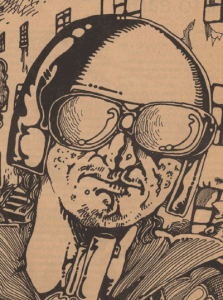
Ollie sank to a chink of clear floor-space. He
shoved wearily at one of the sleeping children.
Eight-year-old Sandra. She woke, a pale, hollow-
eyed child, nearly bald, a few strands of wispy
flaxen hair. “You take this to Pops.” He told
her. “The flag. Tell him to sign the goddamn
release.”
Seeing the flag, the little girl’s eyes flared.
She snatched the bright banner away and ran out
into the hall, ignoring Ollie’s shouts.
She got three bucks for the flag from a
man on the Hundredth Level.
A penny a year.
May 17, 2012
Perspective Police!: Bechdel
I owe Alison Bechdel big time. The cartoonist responsible for the comic strip Dykes To Watch Out For and the graphic novels Fun Home and Are You My Mother? may be best known for The Bechdel Test, which she formulated to determine whether a movie is sexist or not. For a story to pass the test:
1. It has to have at least two women in it,
2. Who talk to each other,
3. About something other than a man.
Some people amend the rules to require that both women have names.
David Chelsea is reading:
Manara Erotica Volume 1
by Milo Manara

Not Passing The Bechdel Test: Panel from The Girl With The Keyhole Eyes.
Even though Bechdel devised this test for movies (some notable ones that fail it: The Godfather, The Graduate, Citizen Kane and the original Star Wars Trilogy) there is no reason it can’t apply to comics; a story is a story. When I first heard about the test I mentally applied it to my own work and was embarrassed to discover that only two stories passed: my first graphic novel David Chelsea In Love, thanks to a single sequence taking up part of two pages (41 and 42 in the Reed Press edition), and the 24 Hour Comic ID, which you can read in its entirety here. I was therefore inspired to create Sandy & Mandy, a story I’m working on for Dark Horse Presents which features two named female friends who talk about everything under the sun as well as the occasional man (I couldn’t resist having a bit of fun with such a P.C. restriction- notice the convoluted way Sandy & Mandy manage to bring up men’s names without actually talking about a man).
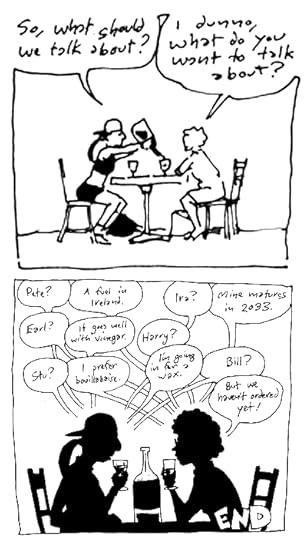
Passing The Bechdel Test: Rough sketch for Sandy & Mandy
So hats off to you, Alison Bechdel, for opening my eyes to my own unconscious sexism. Now let me return the favor by showing you how to improve your perspective.
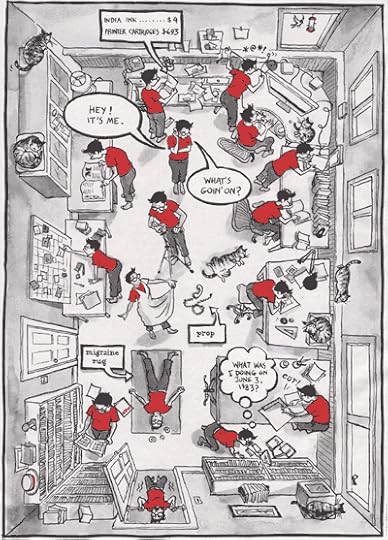
Alison Bechdel illustration for The New Yorker
Here is a recent New Yorker illustration in which Bechdel depicts herself multiply at work in her basement studio. It appears to be a simple one-point perspective view of the basement as seen from overhead, (a view we could only get if the upper floors were removed) but it is actually more complicated than that. It was obvious to me at first glance that the receding lines do not all meet at a single point, which in itself is not terribly surprising- cartoonists often take a loose approach to perspective- but once I began diagramming them out I noticed that the lines do roughly meet at four separate vanishing points- a different one for each side wall.
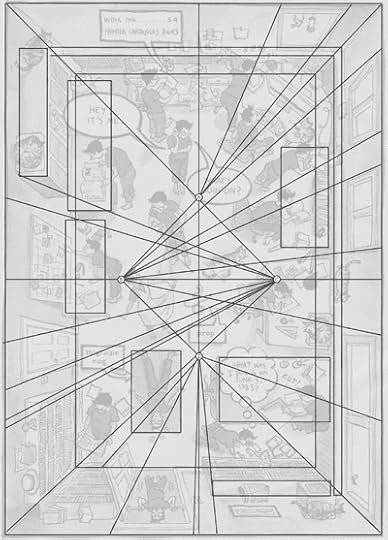
Bechdel diagammed
The method of perspective Bechdel is using is known as vanishing axis or vanishing trace perspective, and it has a long history. Lawrence Wright in his 1983 book Perspective In Perspective gives a good description:

Diagram of Vanishing Axis Perspective
“If the artist wants to show more of both side walls, he can ‘open them out’ slightly without noticeably falsifying the proportions of the room. Each side wall now has its own separate vanishing point, both being on a common horizon. This discrepancy may not be noticeable, but a further problem arises if the orthogonals (receding parallels) of the floor, if they are to meet correctly, now need a third vanishing point, and those of the ceiling a fourth one. These last two fall on a common, vertical ‘vanishing axis’ or ‘vanishing trace’. Vanishing axis perspective often occurs in medieval drawings. It is a quite acceptable formula—if that word can be applied to an arbitrary device for which few rules can be laid down—when used with discretion. It has survived as an occasional remedy for the drawbacks of normal systems of construction.”

Bechdel revised
Whether Bechdel knew about vanishing axis perspective or reinvented the method on her own, it’s a clever solution to the visual problems set by her subject. Setting up the drawing the conventional way with one vanishing point at the center of the picture would mean that the walls to the right and left would be far more foreshortened than those at the top and bottom, an effect that would be even more exaggerated if the vanishing point were placed anywhere else. Using a different vanishing point for each wall enables Bechdel to foreshorten all of them equally (It does mean that the rectangle representing the floor is a different shape than the framing rectangle representing the ceiling, but I’m sure hardly anyone notices that).
While it is pointless to criticize any drawing in vanishing axis perspective for not having all its lines meeting at a central point, that does not mean there is no room for improvement. The method requires that objects and furniture attached to each wall should share the vanishing point of that wall, and Bechdel has not done this consistently. My revision brings wayward objects into line with their particular vanishing point, and I have in a few cases tilted or redrawn the human figures to better align them with the perspective of their particular part of the room. I believe my version improves on Bechdel’s inconsistent construction without destroying the the charm of the original.
Thanks to Wilhelm Schroeder for bringing this piece to my attention.
Got an example of iffy perspective to show? Be a whistleblower! Send an e-mail to me at davidchelsea(at)comcast(dot)net and include Perspective Police! in the subject line.
May 11, 2012
Young Mitt:
David Chelsea's Blog
- David Chelsea's profile
- 8 followers











